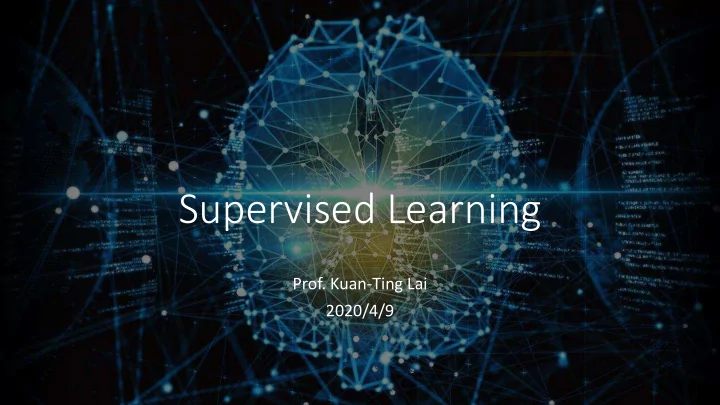

Supervised Learning Prof. Kuan-Ting Lai 2020/4/9
Machine Learning Supervised Unsupervised Reinforcement Learning Learning Learning Deep Classification Clustering Reinforcement ( 離散資料 ) ( 分門別類 ) ( 物以類聚 ) Learning Dimensionality Regression Reduction ( 連續資料 ) ( 回歸分析 ) ( 化繁為簡 ) 2
3
Iris Flower Classification • 3 Classes • 4 Features • 50 samples for each class (Total: 150) • Feature Dimension: 4 − Sepal length (cm), sepal width, petal length, petal width
k-Nearest Neighbors (k-NN) • Predict input using k nearest neighbors in training set • No need for training • Can be used for both classification and regression https://en.wikipedia.org/wiki/K-nearest_neighbors_algorithm
k-NN for Iris Classification • Accuracy = 80.7% • Accuracy = 92.7% sepal width (cm) sepal length (cm) sepal length (cm)
Linear Classifier 𝑦 2 𝑦 1
Training Linear Classifier • Perception 𝑦 2 𝑦 1
Support Vector Machine (SVM) • Choose the hyperplanes that have the largest separation (margin)
Loss Function of SVM • Calculate prediction errors
SVM Optimization • Maximize the margin while reduce hinge loss • Hinge loss:
Multi-class SVM • One-against-One • One-against-All https://courses.media.mit.edu/2006fall/mas622j/Projects/aisen-project/
Nonlinear Problem? • How to separate Versicolor and Virginica?
SVM Kernel Trick • Project data into higher dimension and calculate the inner products https://datascience.stackexchange.com/questions/17536/kernel-trick-explanation
Nonlinear SVM for Iris Classification Accuracy = 82.7%
Logistic Regression • Sigmoid function S-shaped curve 𝑓 𝑦 1 𝑇 𝑦 = 𝑓 𝑦 + 1 = 1 + 𝑓 −𝑦 • Derivative of Sigmoid 𝑇 𝑦 = 𝑇 𝑦 (1- 𝑇 𝑦 ) https://en.wikipedia.org/wiki/Sigmoid_function
Decision Boundary • Binary classification with decision boundary t 1 𝑧′ = 𝑄 𝑦, 𝑥 = 𝑄 𝜄 𝑦 = 1 + 𝑓 − 𝒙 𝑈 𝒚+𝑐 𝑧′ = ቊ0, 𝑦 < 𝑢 1, 𝑦 ≥ 𝑢
Cross Entropy Loss • Loss function: cross entropy loss = ൝− log 1 − 𝑄 𝜄 𝑦 , 𝑗𝑔 𝑧 = 0 − log 𝑄 𝜄 𝑦 , 𝑗𝑔 𝑧 = 1 https://towardsdatascience.com/a-guide-to-neural-network-loss-functions-with-applications-in-keras-3a3baa9f71c5
Cross Entropy Loss • Loss function: cross entropy loss = ൝ − log 1 − 𝑄 𝜄 𝑦 , 𝑗𝑔 𝑧 = 0 − log 𝑄 𝜄 𝑦 , 𝑗𝑔 𝑧 = 1 ⇒ 𝑀 𝜄 (x) = −𝑧 log 𝑄 𝜄 𝑦 + − (1 − y)log 1 − 𝑄 𝜄 𝑦 ∇𝑀 𝑋 (x) = − 𝑧 − 𝑄 𝜄 𝑦 𝑦 https://towardsdatascience.com/a-guide-to-neural-network-loss-functions-with-applications-in-keras-3a3baa9f71c5
Using Neural Network https://www.tensorflow.org/tutorials/customization/custom_training_walkthrough
Classifier Evaluation on Iris dataset https://colab.research.google.com/drive/1CK7NFp6qX0XoGZWqryCDzdHKc3N4nD4J
22
Linear Regression (Least squares) • Find a "line of best fit“ that minimizes the total of the square of the errors
Scikit Learn Diabetes Dataset • Ten baseline variables, age, sex, body mass index, average blood pressure, and six blood serum measurements were obtained for each of n = 442 diabetes patients Samples total 442 Dimensionality 10 Features real, -.2 < x < .2 Targets integer 25 - 346 BMI https://www4.stat.ncsu.edu/~boos/var.select/diabetes.html
Regularization https://towardsdatascience.com/ridge- and-lasso-regression-a-complete-guide- with-python-scikit-learn-e20e34bcbf0b
Ridge, Lasso and ElasticNet • Ridge regression: • Lasso regression: • Elastic Net:
Predicting Boston House Prices 27
Boston Housing Price Dataset • Objective: predict the median price of homes • Small dataset with 506 samples and 13 features − https://www.kaggle.com/c/boston-housing 1 crime per capita crime rate by town. 8 dis weighted mean of distances to five Boston employment centres. 2 zn proportion of residential land zoned for 9 rad index of accessibility to radial highways. lots over 25,000 sq.ft. 3 indus proportion of non-retail business acres per 10 tax full-value property-tax rate per $10,000. town. 4 chas Charles River dummy variable (= 1 if tract 11 ptratio pupil-teacher ratio by town. bounds river; 0 otherwise). 5 nox nitrogen oxides concentration 12 black 1000(Bk - 0.63)^2 where Bk is the proportion of blacks by town. 6 rm average number of rooms per dwelling. 13 lstat lower status of the population (percent). 7 age proportion of owner-occupied units built prior to 1940. 28
Normalize the Data • the feature is centered around 0 and has a unit standard deviation • Note that the quantities (mean, std) used for normalizing the test data are computed using the training data! # Nomalize the data mean = train_data.mean(axis=0) train_data -= mean std = train_data.std(axis=0) train_data /= std test_data -= mean test_data /= std 29
Comparison of Regularization Methods Training Data (506 samples) Test Data (102 samples) Mean Absolute Error (MAE) https://colab.research.google.com/drive/1lgITg2vEmKfgqp7yDtrOCbWmtYuzRwIm
Predicting Housing Price using DNN https://colab.research.google.com/drive/1tJztaaOIxbk_VuPKm8NpN7Cp_XABqyPQ
Final Results
References • https://ml-cheatsheet.readthedocs.io/en/latest/index.html • https://towardsdatascience.com/ridge-and-lasso-regression-a-complete-guide- with-python-scikit-learn-e20e34bcbf0b • https://en.wikipedia.org/wiki/Naive_Bayes_classifier
Recommend
More recommend